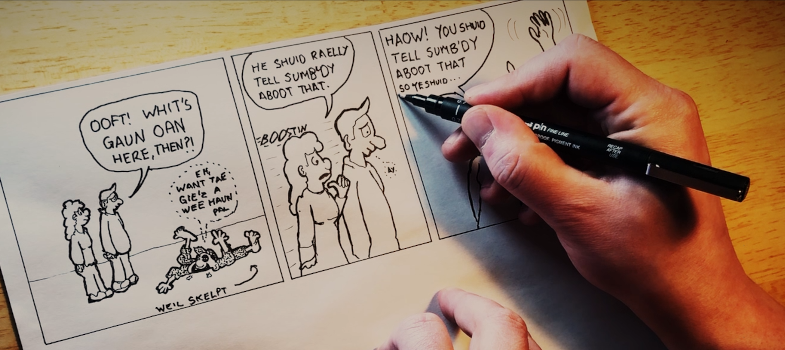Scots Language, Creativity and the Expressive Arts

Activity 2
Read Stevenson’s introduction to her poetry collection Quines and pay particular attention to the connections with the Scots language, from reasons why she has written in Scots to connections her parents had with the language.
Take notes on all these connections and think about an activity you could design for your classroom where your pupils can explore their own connections with Scots at different levels, from family, to education to geography etc.
In this section I will focus on my second poetry collection, Quines: Poems in Tribute to Women of Scotland (Luath Press, 1st edition 2018, 2nd edition 2020). This book celebrates Scottish women from Neolithic times to the 21st century – scientists, artists, politicians, sportswomen (including a whole football team), missionaries, social reformers, a salt seller, queens, a fish gutter, a ship’s captain, and many more, including the greatest fishing fly tyer in the world.
My aim in this collection is to create a sweep of history which examines the contribution that women have made to Scottish society throughout the ages, in spite of the considerable barriers thrown in their path. The poems are written in a range of voices, all monologues in three modes: in the voice of the woman in question, or of another woman who knew her, or something, related to her. Thus, sometimes a human being is speaking, and, at other times, an inanimate object – e.g. a novel, a bank note, or a building. (There are only two poems in my own voice – the first and last.)
In finding voices for these women, I’ve considered the question of Scotland’s three native languages – Gaelic, Scots and English. The missionary Mary Slessor, for example, was born in Aberdeen, brought up in Dundee, and lived most of her adult life in Nigeria. She was fluent in the Efik language, and spoke with a strong Scots accent – indeed often in Scots – as did Jane Haining (another missionary), from a small croft in Dumfriesshire, who was also a linguist.
I’m often asked: “Why do you choose to write in Scots?” This question carries an assumption, i.e. that the act of writing in Scots is a choice, and possibly a political one. For me, it is neither. I write simply in the voice that suggests itself to me, based on instinct and research. And I’m fortunate to have access to two languages – English and Scots. I was born and raised in the Scottish Borders, a daughter of English parents. I grew up hearing Scots spoken in my home village. Around one third of the 62 poems in Quines are in Scots. The majority are in English, and a few refer to Gaelic. Although I’m married to a Gael, and am familiar with Gaelic, I don’t speak it with any fluency. So, where the voices in Quines are Gaelic, I’ve attempted to suggest that language with a hint of its syntax and the inclusion of some Gaelic words within the English. The book contains an extensive glossary.
My father was a composer pianist, who set the words of many Scots language poets to music, including Hugh MacDiarmid, William Soutar and Helen B. Cruickshank, all of whom were involved in the Scottish Renaissance, at the forefront of the revival of the Scots language. So, from early childhood, I was exposed to literature in Scots and connections across art forms, in this case, music and literature, through the creation of songs.
In Quines, various art works have acted as stimuli for the poems – e.g. songs, films, objects and paintings. One of the Scots language poems – The Abdication of Mary Queen of Scots (written in response to a painting of the same title, by Gavin Hamilton), has already been examined in Professor Alan Riach’s Open University unit on Scots language and culture – Part 2, where he discusses a range of Scots dialects in poetry:
https://www.open.edu/openlearncreate/mod/oucontent/view.php?id=147540§ion=2.1
Quines has an international theme. Many of the women celebrated in its poems are immigrants and emigrants. This international aspect connects with Billy Kay’s existing Open University units on Scots Abroad: Scots language and culture Part 2:
https://www.open.edu/openlearncreate/mod/oucontent/view.php?id=147431
In this context it may be relevant to note that Quines is currently being translated into Italian, for publication by Edizioni Ensemble in Rome, 2020. In recent years I’ve given three poetry reading tours of Italy, with the translator, Laura Maniero, and it’s interesting to note that Italian audiences have shown real appetite for the Scots language poems in Quines. Maniero has also translated ‘If this were real’ into Italian. As the work of Robert Burns demonstrates, the Scots language travels well!
Learning Log